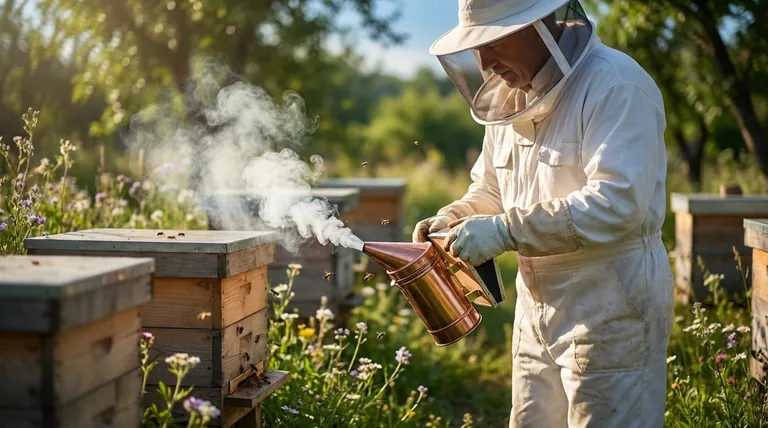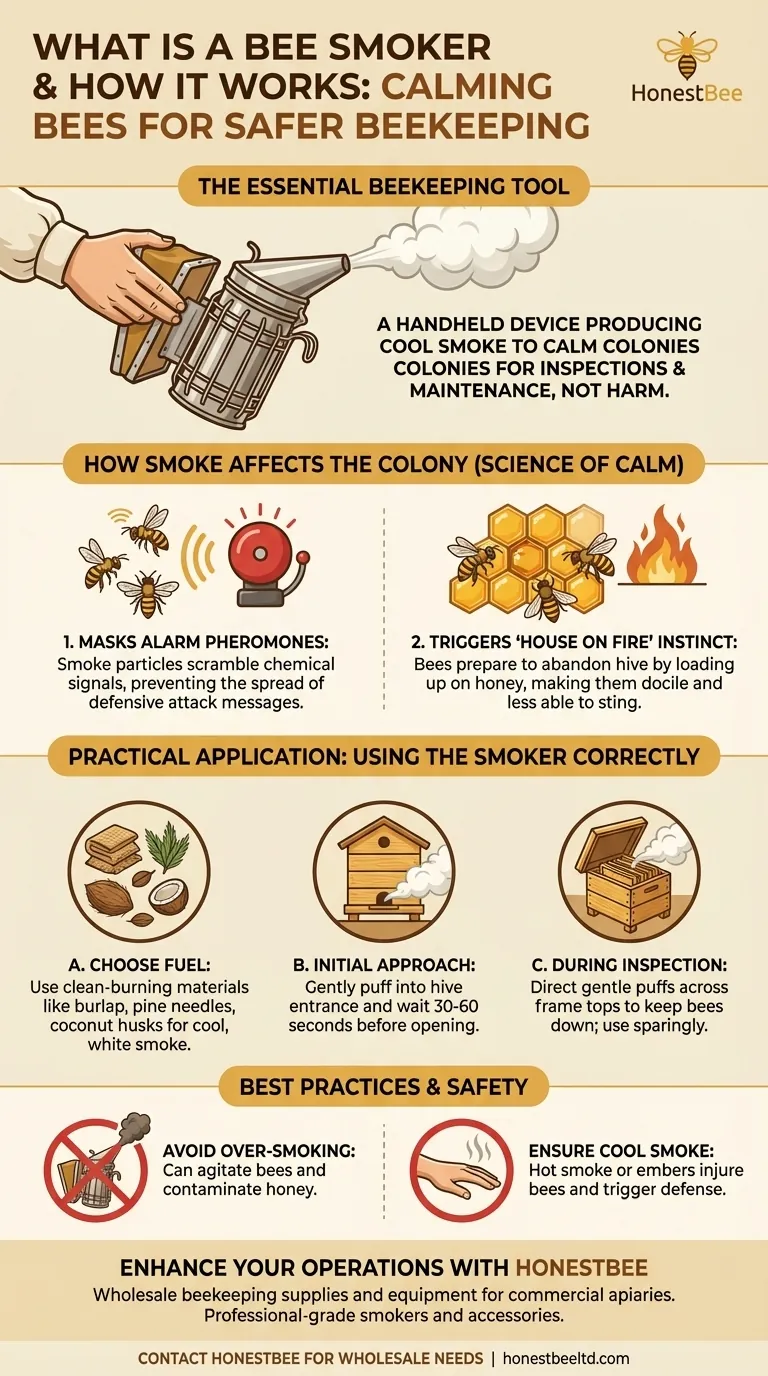At its core, a bee smoker is a handheld device used by beekeepers to produce cool, thick smoke. It consists of a metal fire chamber for burning fuel and a bellows to gently pump air, directing the smoke where it's needed. Its primary purpose is not to harm the bees, but to calm the colony, making hive inspections and maintenance significantly safer and less stressful for both the beekeeper and the bees.
The smoker is arguably the most essential tool in beekeeping because it fundamentally changes bee behavior. It works by masking the natural alarm signals bees use to coordinate a defensive attack, effectively allowing a beekeeper to work without triggering a large-scale stinging response.

How Smoke Actually Works on a Bee Colony
To use a smoker effectively, you must first understand why it works. The effect isn't magic; it's a manipulation of the honey bee's deeply ingrained survival instincts.
Masking Alarm Pheromones
When a bee feels threatened or is crushed, it releases an alarm pheromone. This chemical signal instantly alerts other guard bees in the vicinity, marking a target and inciting a coordinated defensive attack.
Smoke effectively scrambles this communication channel. The strong scent of the smoke particles masks the alarm pheromone, preventing the signal from spreading throughout the colony and stopping a defensive chain reaction before it starts.
Triggering a "House on Fire" Instinct
On a more primal level, the smell of smoke signals a potential forest fire to the bees. Their instinctive response is not to attack, but to prepare to abandon the hive.
To do this, they immediately begin to gorge on honey, loading up on food reserves for the potential journey to a new home. A bee with a full stomach is physically less able to flex its abdomen to sting and is generally more docile and preoccupied with its survival task.
The Practical Application: Using a Smoker Correctly
Knowing the science behind the smoker allows you to use it with precision and care. The goal is finesse, not force.
Choosing Your Fuel
The smoker requires a clean-burning, non-toxic fuel. You want to produce a thick, cool, white smoke.
Common and effective fuels include untreated burlap, dry pine needles, wood shavings, cotton rags, or commercially available smoker fuels. The reference to eco-friendly options like coconut husks is also excellent for a slow, consistent burn.
The Initial Approach
Before you even open the hive, gently puff a few clouds of smoke into the hive entrance. Wait for 30-60 seconds.
This initial application gives the smoke time to circulate and serves as your first signal. It alerts the bees to the "threat" of fire, encouraging them to begin feeding on honey and calming the guards at the entrance.
During the Inspection
Once you remove the lid, direct a few gentle puffs of smoke across the tops of the frames. This pushes the bees down slightly and keeps the communication lines scrambled.
Use the smoke sparingly as you work. If you notice the bees becoming agitated or flying at your veil, apply another gentle puff. The goal is to keep them calm, not to fill the hive with smoke.
Understanding the Trade-offs and Best Practices
While essential, a smoker can be misused. Objectivity requires acknowledging its potential downsides and establishing clear guidelines for responsible use.
The Danger of Over-smoking
Using too much smoke is a common beginner's mistake. It can be counterproductive, causing bees to become agitated or run excessively across the comb.
Excessive smoke can also contaminate the taste of honey and, in extreme cases, harm the bees. Remember: you are creating a diversion, not fumigating the hive.
Always Use Cool, White Smoke
Hot smoke or embers shooting from the smoker can injure or kill bees, which will certainly trigger a defensive response.
Ensure your smoker is well-lit and producing a consistent, cool stream of smoke before you approach the hive. If the smoke feels hot on the back of your hand, give it more time.
It's a Tool, Not a Replacement for Calm Behavior
A smoker is an aid, not a magic wand. It calms the colony's defensive instinct, but the beekeeper's own behavior is just as important.
Always move slowly and deliberately when working a hive. Avoid jerky movements, swatting at bees, or crushing them. The smoker works best when paired with a calm and respectful demeanor.
Applying This to Your Beekeeping
Your use of the smoker should be tailored to the specific task at hand, always with the colony's well-being in mind.
- If your primary focus is a quick, routine inspection: Use minimal smoke—a few puffs at the entrance and one application across the top bars is often sufficient.
- If your primary focus is honey harvesting: You may need to use smoke more deliberately to encourage bees to move down from the honey supers and into the brood boxes below.
- If your primary focus is managing an aggressive colony: Consistent, gentle puffs of smoke are key to keeping the alarm pheromones suppressed throughout the entire inspection.
Ultimately, mastering the smoker is about learning to have a conversation with your bees, using their own instincts to create a peaceful and productive partnership.
Summary Table:
| Key Aspect | Purpose & Effect |
|---|---|
| Primary Function | Calms bees for safer hive inspections and maintenance. |
| How It Works | Masks alarm pheromones and triggers a 'house on fire' instinct, making bees docile. |
| Best Fuel | Clean-burning materials like burlap, pine needles, or coconut husks for cool, white smoke. |
| Key Practice | Use smoke sparingly and gently; over-smoking can agitate bees or contaminate honey. |
Ready to equip yourself with the right tools for safe, effective beekeeping?
HONESTBEE supplies commercial apiaries and beekeeping equipment distributors with high-quality, reliable beekeeping supplies and equipment through our wholesale-focused operations. Ensure your operations run smoothly and safely with our professional-grade smokers and accessories.
Contact HONESTBEE today to discuss your wholesale needs and enhance your beekeeping success!
Visual Guide

Related Products
- Premium Traditional Copper Bee Smoker with Bellows
- Stainless Steel Honey Bee Smoker Hive and Honeycomb Smoker for Beekeeping
- Economy Galvanized Beekeeping Honey Bee Smoker for Wholesale
- Professional Bee Smoker with Elongated Spout and Durable Bellows for Beekeeping
- Heavy Duty Manual Bee Smoker Blower for Beekeeping
People Also Ask
- What is the primary purpose of using smoke in beekeeping? Calm Bees for Safer Hive Management
- What are some alternatives to using smoke in beekeeping? A Guide to Gentle Hive Management
- What happens to bees when they sense smoke? Unlock the Secret to Calm Hive Inspections
- What are the main parts of a bee smoker? Essential Components for Calm Hive Management
- How does water mist work as an alternative to smoke in beehives? A Guide to Safe & Effective Use



















